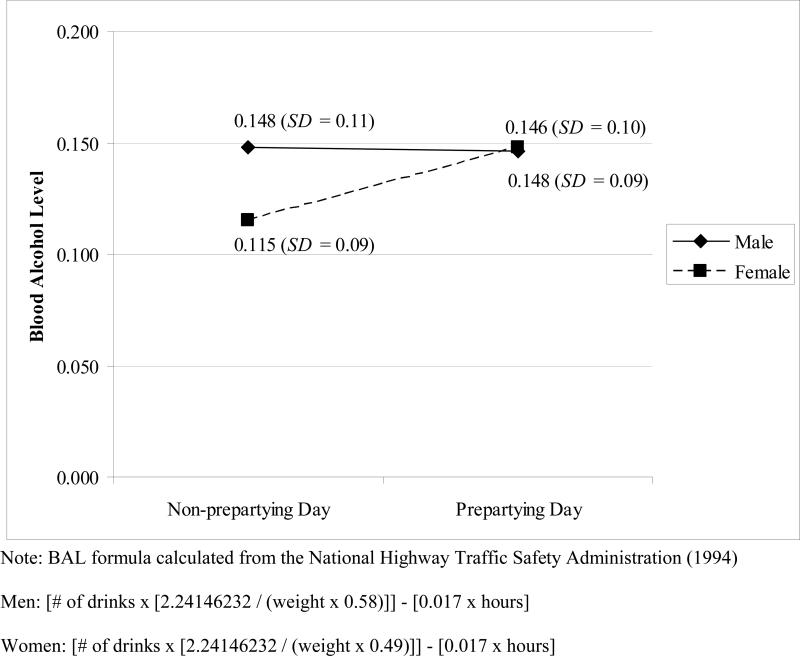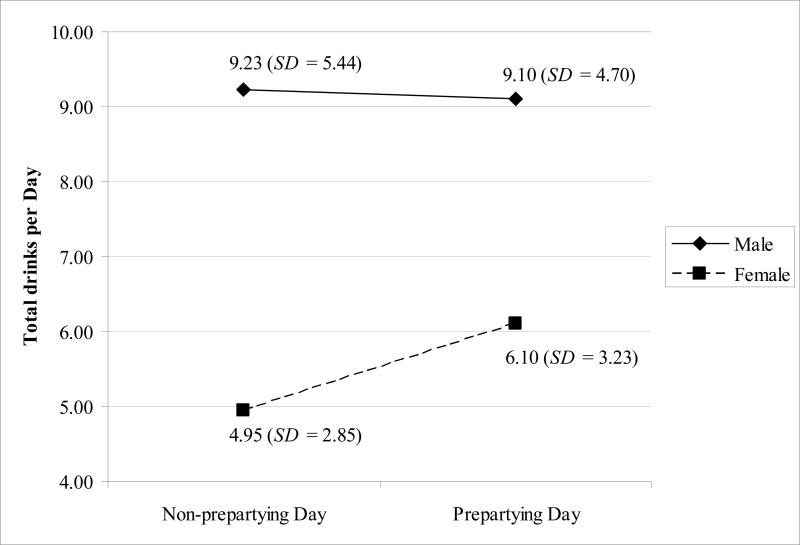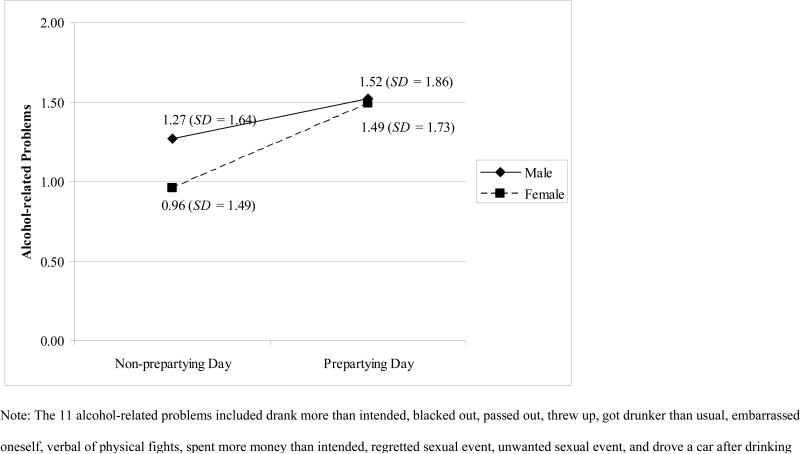Abstract
Due to the emergence of research literature examining the prepartying behavior of college students, the present study examines students’ varying drinking rates, blood alcohol levels (BALs), and alcohol-related consequences during two drinking events – one involving prepartying and one devoid of prepartying. Two-hundred and thirty-eight student drinkers completed an online drinking assessment detailing their two most recent drinking occasions involving and not involving prepartying. Participants responded to a series of questions regarding quantities consumed on the drinking day and occurrence of alcohol-related consequences. While men did not differ in drinking or estimated BALs, between the two drinking days, female participants drank significantly more drinks and reached higher BALs on the prepartying drinking day. Both males and females reported increased experience of alcohol-related consequences on the prepartying drinking day. In analyzing the prepartying drinking day specifically, we found that while men drink more alcohol during prepartying, but both men and women reached similar BALs during the event. Also, mount consumed during prepartying related to further drinking throughout the evening.. It appears that prepartying may influence women to reach comparable levels of intoxication and alcohol-related consequences as their male peers. Quick drinking during prepartying may raise BAC levels and lead to alcohol-related consequences particularly for female students.
1. Introduction
In the effort to reduce risk and associated negative consequences from heavy college alcohol use, researcher attention has expanded from a macro-level of examination to a focus on situation- and context-specific risky drinking, as heavy drinking and resulting consequences may be exacerbated during specific high-risk events or contexts (Neighbors et al., 2007). One context-specific behavior emerging in the literature on college drinking is the high risk activity known to students as “prepartying.” This behavior may also be referenced as “pregaming,” “front-loading,” or “pre-funking” depending on regional or school-specific vernacular. Prepartying refers to drinking before going out to a planned destination (e.g., party, bar, concert, sporting event) at which more alcohol may or may not be consumed (Pedersen & LaBrie, 2007). Two recent studies suggest the emergent need to explore this behavior. In one study, findings suggested a prevalence rate of 75% among student drinkers and associations with alcohol-related problems and further heavy drinking post-prepartying (Pedersen & LaBrie, 2007). Research with adjudicated students has linked prepartying to high blood alcohol levels and to drinking on the night students received an alcohol sanction (Borsari et al., 2007).
1.1 The current study
Despite the clinical and research implications of such findings, empirical examinations of prepartying are sparse in the research literature. In addition, the literature that is available examines global prepartying drinking and does not examine this behavior on an event level. The importance of event level analyses lies in the ability to look at specific drinking events and determine the extent that prepartying contributes to consumption levels problems on a given drinking day. In the current study, we examine two drinking days (one involving prepartying; one not involving prepartying) and hypothesize that participants will drink more total drinks, reach higher BAC levels, and experience more alcohol-related problems on the prepartying drinking day compared to the non-prepartying drinking day. In addition, no published literature examines sex differences related to this behavior and therefore we examine sex as a moderator of consumption levels between drinking days.
2. Methods
2.1 Participants
During one spring semester at a mid-sized West Coast university, 128 students completed a survey of alcohol use for course credit through the university psychology subject pool. Participants received one credit for completing their own survey and were able to recruit one or two non-subject pool acquaintances to complete the survey for additional credits. Participants recruited 175 additional participants for an initial sample of 303 college students. Since we were interested in comparing two specific drinking days, we included only drinkers in the study. Our final sample consisted of 238 student drinkers (60% female, n = 143) with a mean age of 19.51 (SD = 1.32), of which 85% reported prepartying in the past month (85% of both male and female drinkers in the sample prepartied). Ethnicity varied: 54% reported their ethnicity as Caucasian, 21% as Hispanic/Latino, 10% as Asian or Pacific Islander, 10% as “mixed ethnicity,” 3% as African American/Black, 1% as “other,” and 1% as declined to state. Forty-three percent were freshmen, 26% were sophomores, 16% were juniors, and 15% were seniors. The majority of students lived in campus residence halls (75%).
2.2 Design and Procedure
The local Internal Review Board at the university approved the study. Participants completed an online survey of demographic questions regarding age, sex, current weight, and class year, as well as two self-report questions assessing drinking frequency and average quantity in the past month (30 days). Participants were also asked to complete an assessment of their most recent drinking event that involved prepartying and their most recent drinking event that did not. Prepartying was defined as drinking alcohol prior to attending an event or activity [for example a party, bar, or concert] at which more alcohol may or may not be consumed. The non-prepartying drinking event was defined as a day alcohol was consumed at or during an event or activity but not prior to attending that event or activity. For each of the two events, participants reported how many total drinks they consumed throughout the day and over how many hours they drank, how many drinks consumed during prepartying and over how many hours they prepartied (prepartying event only), and whether they experienced any of 11 consequences (see Figure 2). These 11 consequences revealed a reliability alpha of .73 for the prepartying event and .74 for the non-prepartying event and were assessed using a Yes/No response format.
Figure 2.
Blood alcohol level (BAL) reached on prepartying and non-prepartying drinking days for males and females
3. Results
All variables of interest were capped at three standard deviations above the mean. Due to missing data resulting from participants’ incomplete responses, the analyses include only participants who completed all data entry for both the prepartying day and the non-prepartying day.
Figures 1 through 3 contain the means and standard deviations for total drinks, blood alcohol level (BAL), and number of alcohol-related problems among males and females on both drinking days. Men drank more total drinks than women on both the prepartying day, t (191) = 4.74, p < .001, and on the non-prepartying day, t (191) = 6.26, p < .001. However, men and women did not differ in the number of alcohol-related consequences experienced on either day (p = .91 for prepartying day; p = .16 for nonprepartying day).
Figure 1.
Total drinks consumed on prepartying and non-prepartying drinking days for males and females
Figure 3.
Number of alcohol-related problems experienced by males and females on prepartying and non-prepartying drinking days
A 2 (sex) X 2 (preparty day versus non-preparty day) repeated measures ANOVA revealed a significant within subjects effect for drinking day, F (1, 191) = 4.98, p < .05, and a significant drinking day X sex interaction, F (1, 191) = 7.90, p < .01. This suggested that female participants reported larger increases in total drinks consumed on the preparty day compared to the non-prepartying day, d = .03 for men, d = .38 for women (see Figure 1). Using the BAL formula from the National Highway Traffic Safety Administration (1994) we calculated BALs for males and females during each drinking day and during prepartying on the prepartying drinking day. There was a main effect for drinking day on approximated BALs, F (1, 118) = 6.92, p < .01, and a drinking day X sex interaction, F (1, 88) = 10.14, p < .01, with male BALs staying relatively the same between days and women experiencing an increase in BAL by approximately 29% on the prepartying day, d = .09 for men, d = .33 for women (see Figure 2). Finally, there was a main effect for drinking day on alcohol-related consequences, F (1, 199) = 9.15, p < .01, but no drinking day X sex interaction, p = .26, d = .14 for men, d =.33 for women (see Figure 3).
For descriptive purposes, we determined the total drinks consumed and BAL reached during prepartying for both males and females on the prepartying day. During the prepartying event, males drank a mean of 4.85 (SD = 2.61) drinks and women drank a mean of 3.45 (SD = 1.91) drinks, t (199) = 4.36, p < .001. Despite males consuming more drinks during the actual prepartying event, both men and women reached similar BACs during the prepartying event. Men reached a mean BAC of 0.094 (SD = 0.06) and women reached a similar mean BAC of 0.086 (SD = 0.06) during the actual prepartying event, p = .40 Additionally, we wanted to determine if a relationship existed between drinks consumed during prepartying and drinks consumed after prepartying. On the prepartying drinking day, only 21% of participants did not consume more alcohol after the prepartying event. For those who did consume alcohol after the prepartying event, drinks during prepartying and drinks consumed after prepartying correlated at r = .23 (p < .01).
4. Discussion
Consistent with previous findings (Borsari et al., 2007; Pedersen & LaBrie, 2007), this event-level study demonstrates the potentially damaging impact prepartying may have on drinking behavior, BALs, and alcohol-related consequences. Examining two specific drinking events, one involving prepartying and one with no prepartying involved, we found women to drink significantly more drinks and reach higher BALs on the prepartying day compared to the non-prepartying day. Men, however, drank at similar levels and reached similar BALs, regardless of prepartying activity. Both males and females increased the experience of alcohol-related consequences during the prepartying drinking day. Effect sizes for increases in drinking, BALs, and problems among males and females were small to medium (< .5).
The findings partially support our hypotheses. We anticipated both male and female participants to increase drinks and consequences on prepartying days as opposed to non-prepartying days. Although all students experienced more alcohol-related problems on the prepartying day, only women experienced significant increases in drinking behavior and BALs. Perhaps men drink heavily regardless of prepartying activity, as research on college drinking has consistently revealed that college men drink at heavy rates and at levels higher than their female counterparts (Engs & Hanson, 1985; Wechsler et al., 2002). For women however, prepartying may be a dangerous antecedent to heavy drinking and thus, a catalyst for consequences. From the data reported here, it appears that women increased BALs and alcohol consequences to levels nearly matching those of men on the prepartying day, suggesting that while men may consume more drinks overall in an evening, women may use prepartying as a means of matching the intoxication levels (i.e., BALs) of their male peers on a given drinking day.
Interestingly, despite men consuming more drinks than women overall, both reached similar BALs on the prepartying day. The biological differences between men and women resulting in different processes to break down alcohol (Task Force of the National Advisory Council on Alcohol Abuse and Alcoholism, 2002) may contribute to the similarities in number of consequences experienced on the prepartying day. During the prepartying event alone, both male and female students reached BALs over the legal limit for intoxication (> .08), placing them at impaired levels even before going out to potentially continue drinking heavily. In addition, the quick drinking nature of prepartying may place students at increased risk for consequences and may promote further drinking throughout the evening. Similar to previous reports (Pedersen & LaBrie, 2007), drinks consumed during prepartying moderately associated with drinks consumed after the prepartying event.
4.1 Limitations
Limitations include the use of only two events and the reliance on self-report data. Although the aim of this study was to examine only two recent drinking events, reports were based on only a snapshot of behavior. We attempted to control for potential extraneous variables such as assessment during periods of heavy or light drinking (e.g., spring break, immediately prior to mid-terms or finals), by allowing participants to complete the surveys at their leisure throughout one semester. However, participants may have in inadvertently chosen a period of heavy or light drinking for their reports. In addition, despite providing pictures of standard drinks, participants may have overestimated or underestimated their retrospective behavior (White et al., 2005; White, Kraus, McCracken, & Swartzwelder, 2003). Weight, reported drinks, and reported hours spent drinking were used to calculate BALs, but without a true test of actual BALs (i.e., blood test), these values must be interpreted as estimates. Finally, the method of recruitment may have led initial participants to recruit heavier drinkers or friends with similar drinking patterns. We found no significant differences between subject pool participants and recruits on any drinking variable.
4.2 Conclusions
Despite these limitations, these findings highlight the association between prepartying, heavy drinking, and alcohol-related consequences. Particularly for female students, quick drinking during prepartying may facilitate heavier drinking and high BALs, placing them at similar risk for consequences as traditionally heavier drinking male students. As this is the first event-level study describing prepartying behavior, more research is needed to continue to explore the implications of addressing this behavior during interventions with students.
Acknowledgments
This research was funded by the National Institute of Alcohol Abuse and Alcoholism (Grant U18AA015451-01), a Model Award from the U.S. Department of Education (Grant Q184N050003), and a grant from the Alcoholic Beverage Medical Research Foundation.
Footnotes
Publisher's Disclaimer: This is a PDF file of an unedited manuscript that has been accepted for publication. As a service to our customers we are providing this early version of the manuscript. The manuscript will undergo copyediting, typesetting, and review of the resulting proof before it is published in its final citable form. Please note that during the production process errors may be discovered which could affect the content, and all legal disclaimers that apply to the journal pertain.
Contributor Information
Joseph W. LaBrie, Loyola Marymount University, Associate Professor, Heads UP Director, Department of Psychology, 1 LMU Drive, Suite 4700, Los Angeles, CA 90045..
Eric R. Pedersen, University of Washington, Clinical Psychology Doctoral Student, Department of Psychology, Box 351525, Seattle WA 98195-1525. Phone: (206) 616-5765, epeder@u.washington.edu.
References
- Borsari B, Boyle KE, Hustad JT, Barnett NP, Tevyaw TO, Kahler CW. Drinking before drinking: Pregaming and drinking games in mandated students. Addictive Behaviors. 2007;32:2694–2705. doi: 10.1016/j.addbeh.2007.05.003. [DOI] [PMC free article] [PubMed] [Google Scholar]
- Engs RC, Hanson DJ. The drinking patterns and problems of college students: 1983. Journal of Alcohol and Drug Education. 1985;31(1):65–83. [Google Scholar]
- National Highway Traffic Safety Administration . Computing BAC Estimate. Department of Transportation; Washington: 1994. [Google Scholar]
- Neighbors C, Walters ST, Lee CM, Vader AM, Vehige T, Szigethy T, et al. Event-specific prevention: Addressing college student drinking during windows of risk. Addictive Behaviors. 2007;32:2667–2680. doi: 10.1016/j.addbeh.2007.05.010. [DOI] [PMC free article] [PubMed] [Google Scholar]
- Pedersen ER, LaBrie JW. Partying before the party: Examining “prepartying” behavior among college students. Journal of American College Health. 2007;56:237–245. doi: 10.3200/JACH.56.3.237-246. [DOI] [PMC free article] [PubMed] [Google Scholar]
- Task Force of the National Advisory Council on Alcohol Abuse and Alcoholism . A call to action: Changing the culture of drinking at U.S. colleges (NIH Publication No. 02-5010) National Institute on Alcohol and Abuse and Alcoholism; Rockville, MD: 2002. [Google Scholar]
- White AM, Kraus CL, Flom J, Kestenbaum L, Mitchell J, Shah K, Swartzwelder HS. College students lack knowledge of standard drink volumes: Implications for definitions of risky drinking based on survey data. Alcoholism: Clinical and Experimental Research. 2005;29:631–638. doi: 10.1097/01.alc.0000158836.77407.e6. [DOI] [PubMed] [Google Scholar]
- White AM, Kraus CL, McCracken LA, Swartzwelder HS. Do college students drink more than they think? Use of a free-pour paradigm to assess how college students define standard drinks. Alcoholism: Clinical and Experimental Research. 2003;24:1751–1756. doi: 10.1097/01.ALC.0000095866.17973.AF. [DOI] [PubMed] [Google Scholar]





